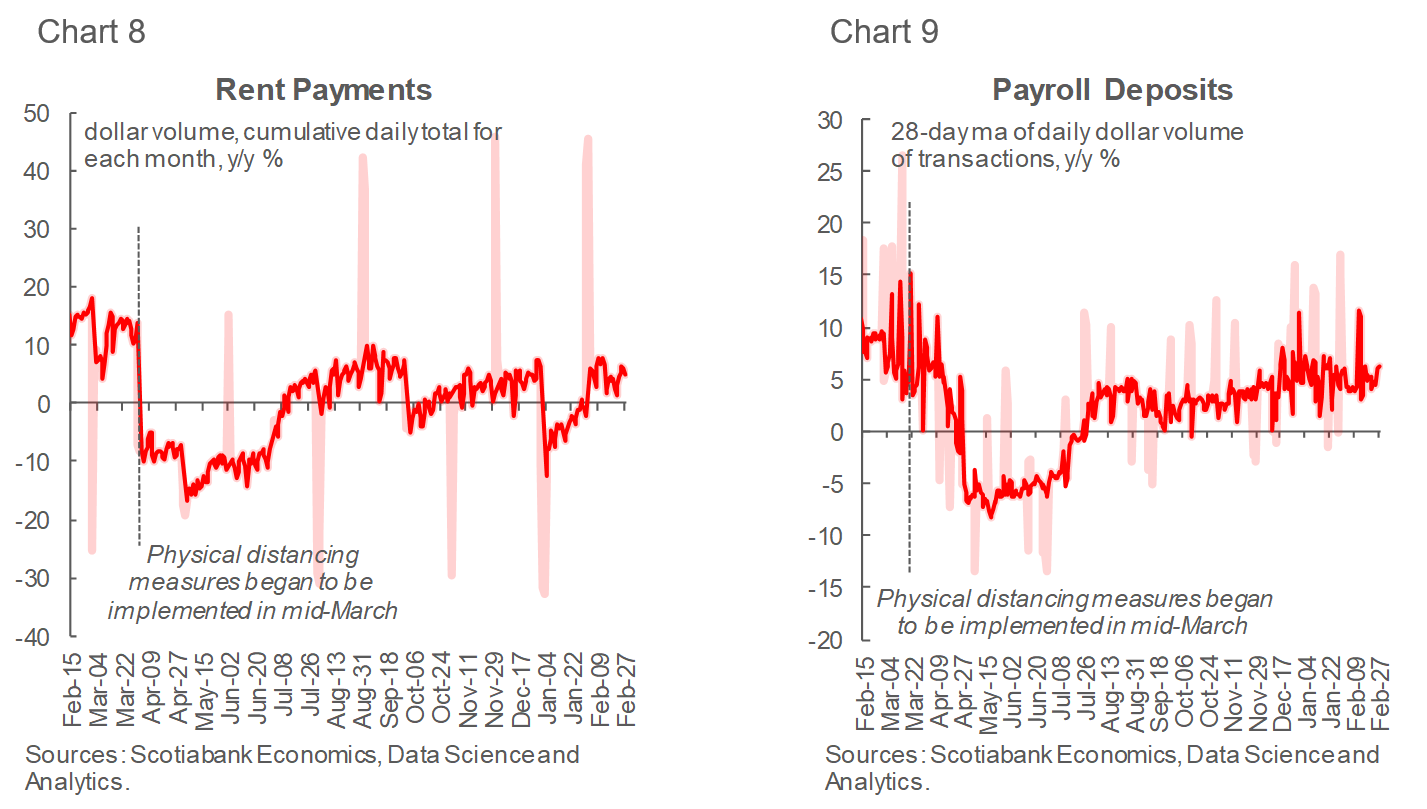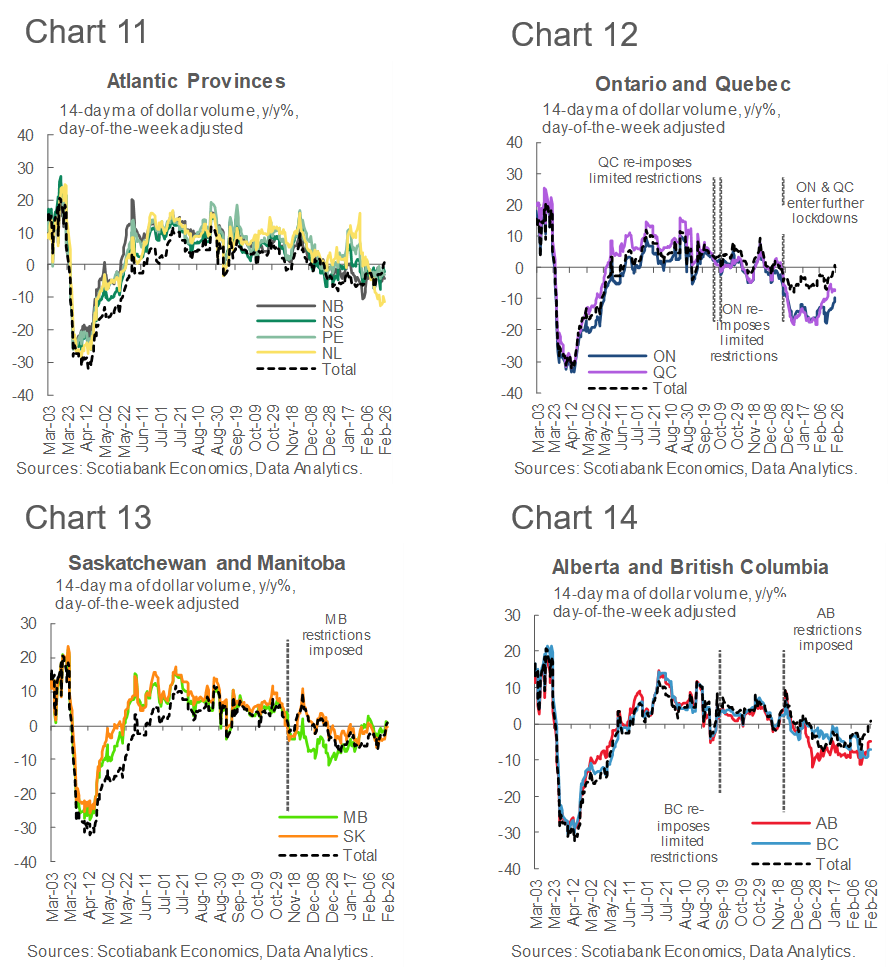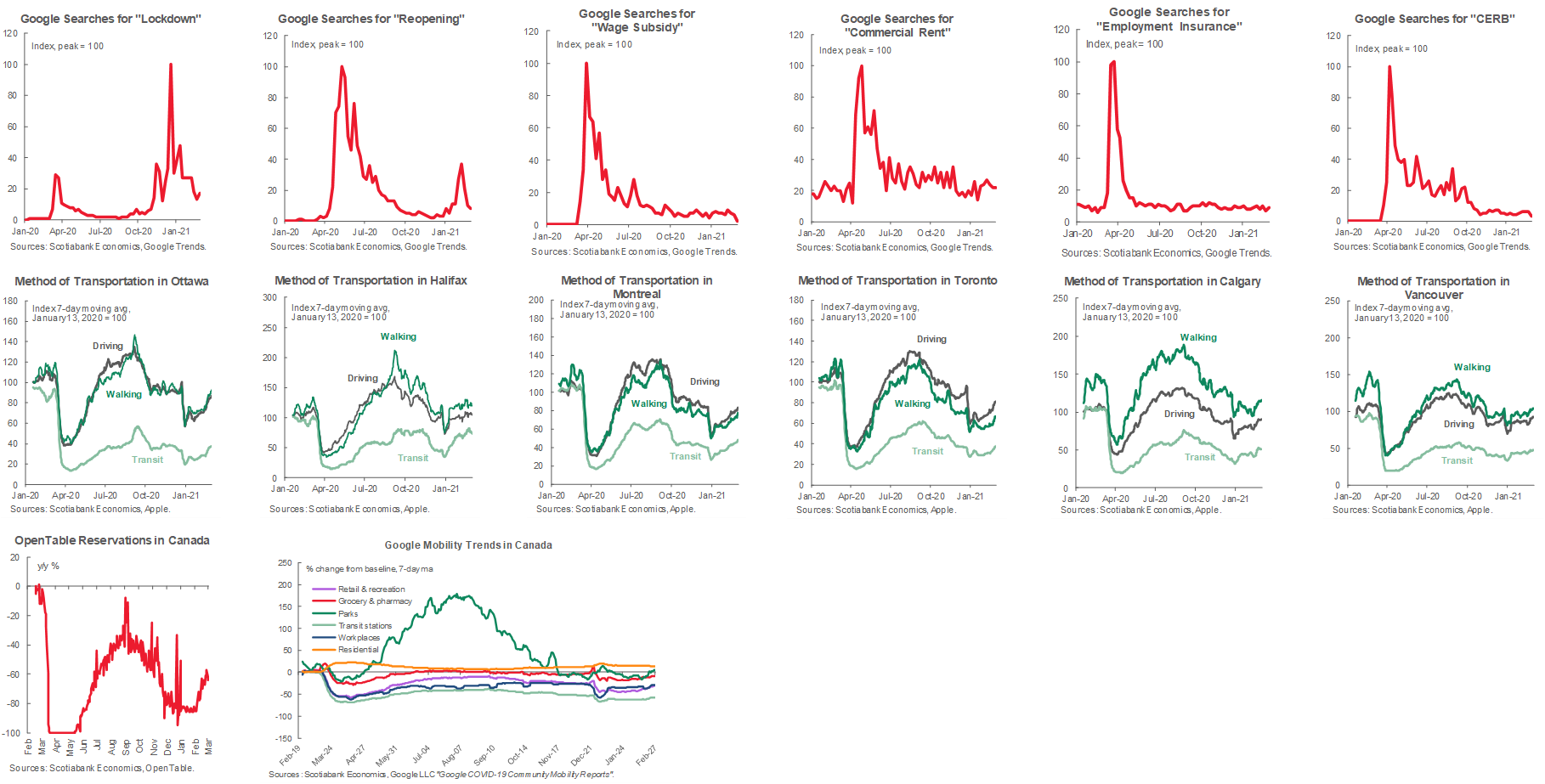Overview
- Key Insights from Customer Transactions
- COVID-19, the Canadian Economy and Scotiabank’s Transactions Data
- Business Transactions Data Details
- Retail Transactions Data Details
- Other High-Frequency Indicators of Activity
- Caveats
1. Key Insights from Canadian Customer Transactions
This presentation is part of the weekly series intended to draw insights about the state of the Canadian economy from the flow of Scotiabank’s retail and non-retail transactions data.
Key takeaways from the payments data in this week’s publication:
Updated to February 27th, business sector transactions continued to run significantly above last year’s levels, in line with indications from Statistics Canada that the latest round of restrictions imposed in early 2021 is having a muted impact on the economy outside the retail sector:
Incoming payments showed steady positive y/y growth since the start of 2021, with wholesale, retail and financial services sectors boosting the overall growth. Payments to the wholesale sector picked up significantly since early January, supporting the preliminary assessment from Statistics Canada that wholesale sales rose in January, despite the tighter restrictions imposed in January. Manufacturing payments have improved so far in 2021, also a positive sign.
Growth in outgoing payments remained stable, supported by steady payroll deposits and improving rent payments. Growth in rental payments turned positive in late January, possibly in response to the rising reach of pickup in the emergency rent subsidy program (CERS).
Growth in consumer card spending improved further in the second half of February (data to February 26th), as public health measures started to be relaxed in some regions:
The improvement can be seen in the hardest-hit provinces such as Ontario, Quebec, Manitoba and Saskatchewan.
Purchases of clothing, hardware and automotive products saw growth pick up significantly since the lockdown-induced dip in January.
2. COVID-19 and the Canadian Economy: Scotiabank Transactions Data
We present data on retail and non-retail transactions, which capture distinct but related aspects of economic activity in Canada.
The data comprises actual observed daily transactions going through debit or credit card payment networks in the retail space, and automated funds transfers (AFTs) in the non-retail space.
The transactions are anonymized and aggregated to protect the privacy of Scotiabank’s clients.
The AFT payments show bill payments to/from companies in Canada.
Incoming payments can be associated with company revenue, and outgoing payments can be associated with costs.
Debit and credit card payments can be used to measure the evolution of retail spending at various types of establishments.
The transactions can serve as a measure of economy-wide retail spending, and of the extent to which households are resuming pre-COVID levels of activity.
Note that the use of electronic payments has increased because of COVID-19, so comparisons to year-ago levels can be misleading. These data are best used to observe directional movements rather than to make specific assessments on the level of activity.
In the current circumstances, comparing the dollar volumes of transactions in the current year to its level of a year ago should help track growth through the re-opening phase.
3. Business Transactions Data: Business Payments Continue to Show Resilience
Updated to February 27th, business sector transactions continued to run significantly above last year’s levels, in line with indications from Statistics Canada that the latest round of restrictions imposed in early 2021 is having a muted impact on the economy outside the retail sector (Chart 1):
Incoming payments showed steady positive y/y growth since the start of 2021, with wholesale, retail and financial services sectors boosting the overall growth.
Payments to the wholesale sector picked up significantly since early January, while manufacturing payments have finally started to improve in 2021 (Charts 2-6).

3. Business Transactions Data: Wholesale Transactions Rise Further

3. Business Transactions Data: Manufacturing Picks Up

3. Business Transactions Data: Growth in Bill Payments Positive
The Canada Emergency Rent Subsidy program continued to ramp up through February, with the most recent data showing over 1.4 billion dollars approved so far (data to February 21, 2021).
Stable rises in payroll deposits highlight the muted impact of the latest round of restrictions seen so far in the labour markets outside of retail and hospitality sectors.
Growth in outgoing payments remained stable, supported by steady payroll deposits and improving rent payments. Growth in rental payments turned positive in late January, possibly in response to the rising reach of pickup in the emergency rent subsidy program (CERS) (Charts 7-9).

3. Business Transactions Data: Rent Payments Finally Show Positive Growth Y/Y

4. Retail Transactions Data: Total Spending Improved Over the Last Few Weeks
Growth in consumer card spending improved further in the second half of February (data to February 26th), as public health measures started to be relaxed in some regions (Chart 10).
Debit card spending has picked up in the last few weeks, explaining most of the improvement, while credit cards remain underutilized.

4. Retail Transactions Data: Hard-hit Provinces Starting to Recover
- The improvement in card spending seen in the last few weeks is mainly explained by rising growth in hardest-hit provinces such as Ontario, Quebec, Manitoba and Saskatchewan (Charts 11-14).

4. Retail Transactions Data: Overall Growth Slightly Positive, Despite Travel-Related Drag
- While travel spending remains the largest source of drag on growth, shopping in other sectors improved enough to push overall growth into a slightly positive territory (Chart 15).

4. Retail Transactions Data: Hard-hit Sectors Show Better Spending Trends
Strong housing markets so far in 2021 no doubt boosted demand for home renovation products as households prepare homes for sale and/or make living arrangements more comfortable as they spend more time at home.
Purchases of clothing, hardware and automotive products rose significantly following the relaxed restrictions in some regions (Chart 16).

4. Retail Transactions Data: Purchases of Digital Media Subside Recently
- Purchases of digital products and spending at large online retailers took a breather in late February after capitalizing on a significant pick-up in demand around holidays (Chart 17).

5. Other High-Frequency Indicators Of Activity
Charts 18-31 Google Searches, Various Keywords, Dining and Transportation Data

6. Caveats
Note that the mapping from the volume of transactions to measures of economic activity (e.g. GDP) is imperfect, and so care must be taken when drawing the implications.
The data is observed at daily frequency and embeds different types of seasonal patterns.
For retail payments, the volume and types of payments are different depending on the day of the week and the season.
For non-retail payments, both the day of the week and the season are important. In addition, some payments are tied to the calendar date (e.g. rent payments are made on the first day of each month), some payments have a bi-weekly schedule, etc.
To smooth out most of the day-to-day seasonality we use a 14-day moving average of the dollar volume of transactions, taking a y/y% change to remove any remaining seasonal patterns related to the calendar date.
In addition to seasonality, there is normal payment volatility related to the random nature of the transactions process and the impact of regional and economy-wide events (weather, labour strikes, etc.).
The volatility of this nature may or may not be related to economic activity as measured by GDP and so, as mentioned above, care must be taken in drawing inference.
For business transactions, which are inherently more lumpy compared to retail spending, data towards the end of the sample can be revised as some AFT payments are recorded with a lag. As a result we exclude the last few days of data of business transactions only.
Nikita Perevalov* (Scotiabank Economics)
Taha Jaffer, Jason Liang (Data Science and Analytics)
Roland Merbis, Artur Motruk (Customer Insights & Analytics)
* Director of Economic Forecasting, 437.775.5137, nikita.perevalov@scotiabank.com
DISCLAIMER
This report has been prepared by Scotiabank Economics as a resource for the clients of Scotiabank. Opinions, estimates and projections contained herein are our own as of the date hereof and are subject to change without notice. The information and opinions contained herein have been compiled or arrived at from sources believed reliable but no representation or warranty, express or implied, is made as to their accuracy or completeness. Neither Scotiabank nor any of its officers, directors, partners, employees or affiliates accepts any liability whatsoever for any direct or consequential loss arising from any use of this report or its contents.
These reports are provided to you for informational purposes only. This report is not, and is not constructed as, an offer to sell or solicitation of any offer to buy any financial instrument, nor shall this report be construed as an opinion as to whether you should enter into any swap or trading strategy involving a swap or any other transaction. The information contained in this report is not intended to be, and does not constitute, a recommendation of a swap or trading strategy involving a swap within the meaning of U.S. Commodity Futures Trading Commission Regulation 23.434 and Appendix A thereto. This material is not intended to be individually tailored to your needs or characteristics and should not be viewed as a “call to action” or suggestion that you enter into a swap or trading strategy involving a swap or any other transaction. Scotiabank may engage in transactions in a manner inconsistent with the views discussed this report and may have positions, or be in the process of acquiring or disposing of positions, referred to in this report.
Scotiabank, its affiliates and any of their respective officers, directors and employees may from time to time take positions in currencies, act as managers, co-managers or underwriters of a public offering or act as principals or agents, deal in, own or act as market makers or advisors, brokers or commercial and/or investment bankers in relation to securities or related derivatives. As a result of these actions, Scotiabank may receive remuneration. All Scotiabank products and services are subject to the terms of applicable agreements and local regulations. Officers, directors and employees of Scotiabank and its affiliates may serve as directors of corporations.
Any securities discussed in this report may not be suitable for all investors. Scotiabank recommends that investors independently evaluate any issuer and security discussed in this report, and consult with any advisors they deem necessary prior to making any investment.
This report and all information, opinions and conclusions contained in it are protected by copyright. This information may not be reproduced without the prior express written consent of Scotiabank.
™ Trademark of The Bank of Nova Scotia. Used under license, where applicable.
Scotiabank, together with “Global Banking and Markets”, is a marketing name for the global corporate and investment banking and capital markets businesses of The Bank of Nova Scotia and certain of its affiliates in the countries where they operate, including; Scotiabank Europe plc; Scotiabank (Ireland) Designated Activity Company; Scotiabank Inverlat S.A., Institución de Banca Múltiple, Grupo Financiero Scotiabank Inverlat, Scotia Inverlat Casa de Bolsa, S.A. de C.V., Grupo Financiero Scotiabank Inverlat, Scotia Inverlat Derivados S.A. de C.V. – all members of the Scotiabank group and authorized users of the Scotiabank mark. The Bank of Nova Scotia is incorporated in Canada with limited liability and is authorised and regulated by the Office of the Superintendent of Financial Institutions Canada. The Bank of Nova Scotia is authorized by the UK Prudential Regulation Authority and is subject to regulation by the UK Financial Conduct Authority and limited regulation by the UK Prudential Regulation Authority. Details about the extent of The Bank of Nova Scotia's regulation by the UK Prudential Regulation Authority are available from us on request. Scotiabank Europe plc is authorized by the UK Prudential Regulation Authority and regulated by the UK Financial Conduct Authority and the UK Prudential Regulation Authority.
Scotiabank Inverlat, S.A., Scotia Inverlat Casa de Bolsa, S.A. de C.V, Grupo Financiero Scotiabank Inverlat, and Scotia Inverlat Derivados, S.A. de C.V., are each authorized and regulated by the Mexican financial authorities.
Not all products and services are offered in all jurisdictions. Services described are available in jurisdictions where permitted by law.

